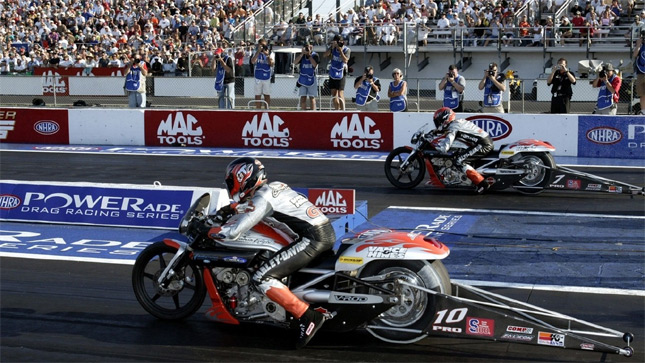 Every single rider out in the world has done a drag race at some point in his life. It is the staple measure of one’s ability to control his bike under high speed. It is the standard test of throttle control and proper shifting but just like any other sport this simple test takes on a very complex form when done professionally. In everyday drag racing, you just need two well-equipped guys with fast motorcycles who are willing to race. In professional drag racing, you need a calm-minded, focused and well-trained individual who can react to a stimulus within a millisecond. Drag racing is a simple yet strenuous sport, let’s look at 5 reasons why.
Every single rider out in the world has done a drag race at some point in his life. It is the staple measure of one’s ability to control his bike under high speed. It is the standard test of throttle control and proper shifting but just like any other sport this simple test takes on a very complex form when done professionally. In everyday drag racing, you just need two well-equipped guys with fast motorcycles who are willing to race. In professional drag racing, you need a calm-minded, focused and well-trained individual who can react to a stimulus within a millisecond. Drag racing is a simple yet strenuous sport, let’s look at 5 reasons why.1: Not just big bikes-
Usually, we see a single straight race from Point A to Point B and that concludes the whole event. Actually, there is more than just 1 round of racing. Rider’s first warm up with their starter bike which includes a 250 or a 300 cc bike. Slowly and steadily through 600 and 800cc, the riders finally get ready to take out the big 1400 cc monsters for the final actual race. Besides having their own class, the entry-level motorcycles are extensively used for warm-ups both by professionals and amateurs.
2: More than just an extended swingarm:
When we think about a drag race bike, the first thing which comes in our mind is an extended swing arm. That’s just one part of the whole game. These bikes also include weight reduction body kits, sports exhaust, lowered suspensions, Quick Shifters, air-shifters, sticky tyres, racing clutch etc. A total of $2000 worth of mods are standard on every drag bike. This number is bound to go up if you were to examine a championship bike.
3: No time:
Every single millisecond counts in a drag race. You can’t even waste time to change the position of your arms and legs during a drag race and the wind pressure from the front is so strong that it makes it almost impossible to do so. That’s why an air-shifter is installed in the motorcycle to make sure that you shift seamlessly throughout your race. The air-shifter cuts off the fuel supply and ignition momentarily to inject in almost 120 PSI of air to shift your bike into the next gear. The switch of the shifter is located on the handlebar in the position of the turn signal. Riders usually use it shift into the first gear so they can shift into the rest of the gear without changing their foot position.
4: Burnout is not just for show:
The starting burnout is an important part of the whole race. Although the drag strips are specially designed to make tyres stick, due to the presence of VHT track bike. The rear tyre needs more traction, especially at 250 km/h. Burnouts are not long and usually include letting the tyre move freely in its position for a while before releasing the clutch.
5: No wheelie:
During a drag race, the rider needs to stay completely in contact with the road. Even a small lift-up will result in a drastic loss, hence extended swing arms are installed in the motorcycles. The winner of the race is decided by each rider’s elapsed time which is defined as the time taken by the rider to leave its starting point and cross the finish line. The goal is to have a small elapsed time as possible.
There are still a million things about drag racing, which, everyday riders like me and several thousand know nothing about. Judging by the small glimpse of information it is easy to see that it is just as intricate and complex as any other form of Motorcycle racing.
By: Yetnesh Dubey
Types Of Motorcycle Racing- Drag Racing
Dated: 5th Jul'16
Drag racing is one sport which has recently caught the fancy of the Indian Automobile lovers. Due to the unavailability of a proper drag strip, we have been illegally or rather unofficially doing it since a long time. Though, things have now changed with events like the Valley Run happening here regularly thanks to the wonderful people at Elite Octane Inc. Period.
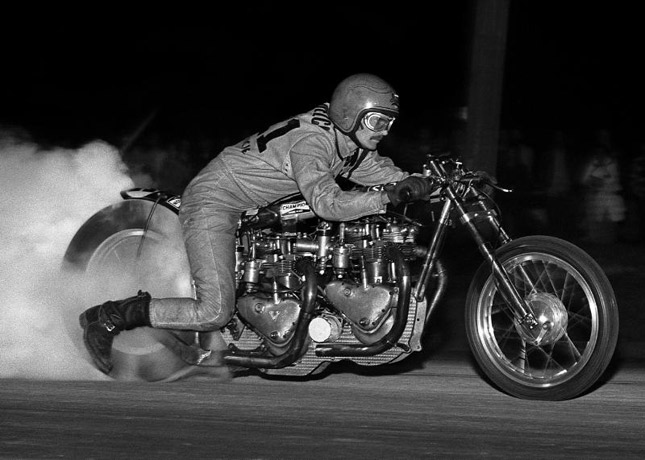 Do you know Drag Racing started back in late 1940 in the US? It started off by being illegal races done by high school teenagers who wanted to show off their mechanical skills by racing modified cars. In the beginning, it was just a standing start sprint of two cars over the same short distance. It was initially done on dry lake beds or two lane strips of roadway. It was not until 1950, when the first official drag racing strip was built by C.J.Hart. It was legal and provided a safe environment which increased participation amongst drivers and mechanics.
Do you know Drag Racing started back in late 1940 in the US? It started off by being illegal races done by high school teenagers who wanted to show off their mechanical skills by racing modified cars. In the beginning, it was just a standing start sprint of two cars over the same short distance. It was initially done on dry lake beds or two lane strips of roadway. It was not until 1950, when the first official drag racing strip was built by C.J.Hart. It was legal and provided a safe environment which increased participation amongst drivers and mechanics.
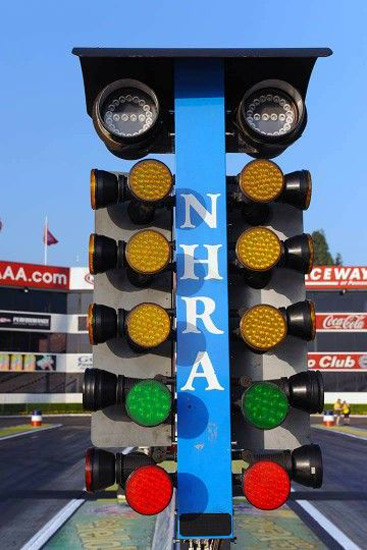 The rules of Drag Racing is simple (or may be not so simple). Two racers line up at the starting line which is controlled by a signal known as the "Christmas Tree". When the green race start light is flashed, the riders race down a ¼ th mile (the standard distance of a drag race is 1320 feet, 402 m which is ¼ mile but due to safety concerns, they are nowadays shortened to 1000 feet) long distance from their respective lanes. The one who crosses the finish line first wins. The racers reaction time, elapsed time and speed are recorded as well. It may sound simple on paper, but in reality it's a lot more difficult. If you have a reaction time of even -.010 sec, you will be disqualified. Let me explain the rules in some more detail.
The rules of Drag Racing is simple (or may be not so simple). Two racers line up at the starting line which is controlled by a signal known as the "Christmas Tree". When the green race start light is flashed, the riders race down a ¼ th mile (the standard distance of a drag race is 1320 feet, 402 m which is ¼ mile but due to safety concerns, they are nowadays shortened to 1000 feet) long distance from their respective lanes. The one who crosses the finish line first wins. The racers reaction time, elapsed time and speed are recorded as well. It may sound simple on paper, but in reality it's a lot more difficult. If you have a reaction time of even -.010 sec, you will be disqualified. Let me explain the rules in some more detail.Rules of Motorcycle Drag Racing:
* Riders usually perform burnouts at the start of the race to heat up the tyre for better traction. They then line up at the starting line. Nowadays, mostly all the races are started electronically by the Christmas tree. It consists of a column of lights for each rider/lane and two light beam sensors per lane on the track at the starting line. There’s one blue light split into halves, then three ambers, one green and one red. When the bike’s front tyre reaches around 7 inches from the starting line (detected by the light beam sensor), it means the bike is “pre-staged” and the first half of the blue light turns on.
READ ALSO: Motorcycle Drag Racing From India’s Perspective
* When the second light beam is broken, the vehicle is “staged” and the second half of the blue light comes on. Simply put, the pre staged lights warn the racers that they are approaching the starting line and the staged position. The staged lights signal the racers that they are on the side lines and ready for a run. These lights are turned on when the front wheel of the bike interrupts the infrared beam. The three amber starting lights flash simultaneously before the green light comes on.
* The system runs with a four-tenths difference between the amber and the green light. A perfect reaction time is .000 seconds. The racers actually react to the flash of the amber light because it takes a split second for them to react and the same amount of time for their bike to move. But, if you jump too soon, that will trigger the dreaded red light which means you have been disqualified and have already lost the race. The first rider to cross the finish line is the winner.
READ ALSO: Motorcycle Drag Racing From India’s Perspective
* When the second light beam is broken, the vehicle is “staged” and the second half of the blue light comes on. Simply put, the pre staged lights warn the racers that they are approaching the starting line and the staged position. The staged lights signal the racers that they are on the side lines and ready for a run. These lights are turned on when the front wheel of the bike interrupts the infrared beam. The three amber starting lights flash simultaneously before the green light comes on.
* The system runs with a four-tenths difference between the amber and the green light. A perfect reaction time is .000 seconds. The racers actually react to the flash of the amber light because it takes a split second for them to react and the same amount of time for their bike to move. But, if you jump too soon, that will trigger the dreaded red light which means you have been disqualified and have already lost the race. The first rider to cross the finish line is the winner.
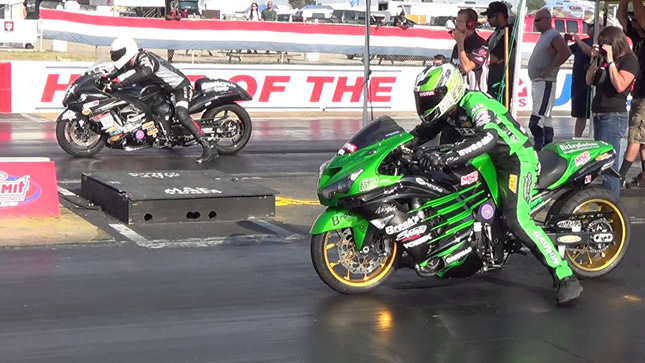 There are categories in the Motorcycle drag racing. Namely, the Pro Stock Motorcycle, Street ET, Top Fuel, Pro Open, Funny Bikes, Pro Mods along with some other categories. Motorcycles in the Top Fuel category are fueled by Nitro Methane and can make around 1,500 horses. The current world record is held by Peter Svensson of Sweden who did a quarter mile in 5.709 seconds. Elmer Trett is considered by many to be the greatest motorcycle drag racers ever. Dave Schultz was the most successful racer in the Pro Stock Motorcycle category with six championships to his name.
There are categories in the Motorcycle drag racing. Namely, the Pro Stock Motorcycle, Street ET, Top Fuel, Pro Open, Funny Bikes, Pro Mods along with some other categories. Motorcycles in the Top Fuel category are fueled by Nitro Methane and can make around 1,500 horses. The current world record is held by Peter Svensson of Sweden who did a quarter mile in 5.709 seconds. Elmer Trett is considered by many to be the greatest motorcycle drag racers ever. Dave Schultz was the most successful racer in the Pro Stock Motorcycle category with six championships to his name.
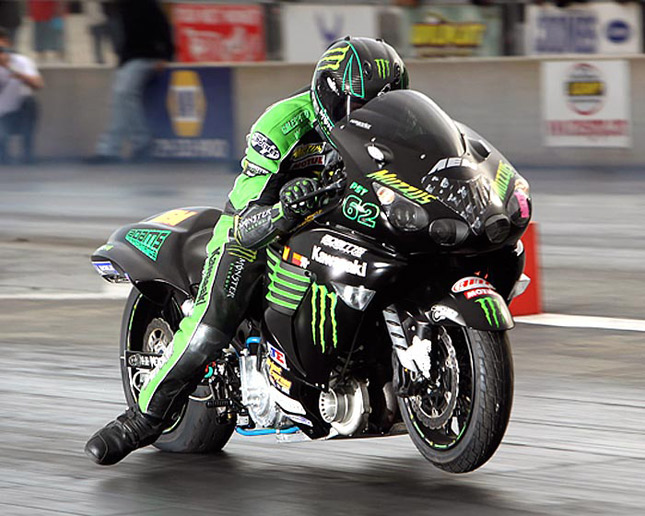 Rickey Gadson is one name that instantly comes to the mind when one mentions Drag Racing. In 1998, he became the first factory-backed (Kawasaki) rider in the entire history of the sport. He is the winner of 11 National Championships and over 200 national events, has won the most number of races in the AMA Drag Racing and is rightly considered as the king of motorcycle drag racing.
Rickey Gadson is one name that instantly comes to the mind when one mentions Drag Racing. In 1998, he became the first factory-backed (Kawasaki) rider in the entire history of the sport. He is the winner of 11 National Championships and over 200 national events, has won the most number of races in the AMA Drag Racing and is rightly considered as the king of motorcycle drag racing.
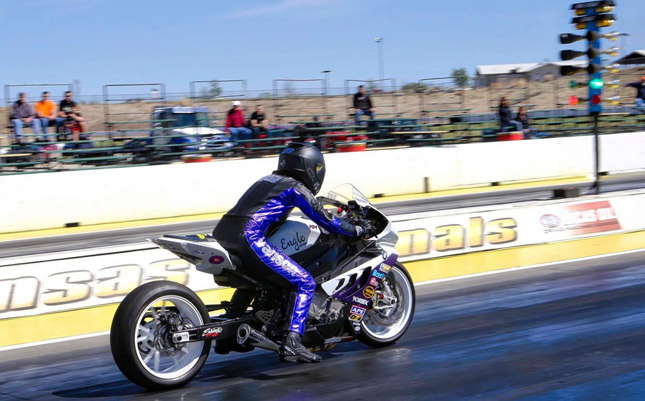 Other big names are Mike Slowe, Keith Dennis, Nick Mazeika & Richard Gadson. Lately, this is one racing sport where we can see a lot of female racers participating. Elyse McKinnon, Crystal Dickerson Jackson, Petey Verrett, Dystany Spurlock, Traci Lewis, Kelly Clontz and Edythe Decker are a few names who are doing well amongst others. Currently, the AMA Dragbike, MIROCK Racing, IDBL, Harley-Davidson Drag Series are the ones to watch out for. Like any other Motor Racing Sport, drag racing is also a dangerous sport with many casualties. The racers need to have trust in their instinct along with immense amount of concentration and control while riding.
Other big names are Mike Slowe, Keith Dennis, Nick Mazeika & Richard Gadson. Lately, this is one racing sport where we can see a lot of female racers participating. Elyse McKinnon, Crystal Dickerson Jackson, Petey Verrett, Dystany Spurlock, Traci Lewis, Kelly Clontz and Edythe Decker are a few names who are doing well amongst others. Currently, the AMA Dragbike, MIROCK Racing, IDBL, Harley-Davidson Drag Series are the ones to watch out for. Like any other Motor Racing Sport, drag racing is also a dangerous sport with many casualties. The racers need to have trust in their instinct along with immense amount of concentration and control while riding.By: Akshay Tajbije











